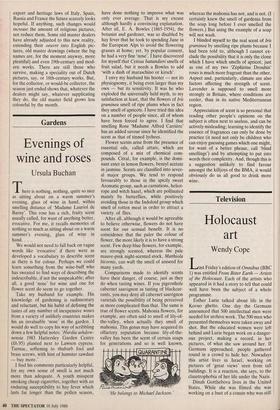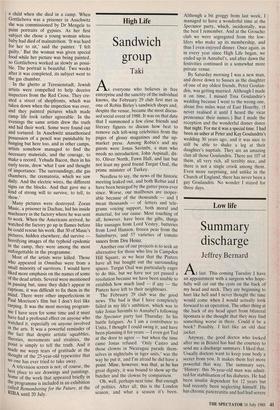Television
Holocaust art
Wendy Cope
Last Friday's edition of Omnibus (BBC 1) was entitled From Bitter Earth — Artists of the Holocaust. Each of the artists who appeared in it had a story to tell that could well have been the subject of a whole programme.
Esther Lurie talked about life in the Kovno ghetto. One day the Germans announced that 500 intellectual men were needed for archive work. The 500 men who presented themselves were taken away and shot. But the educated women were left behind and Lurie began work on a danger- ous project, making a record, in her pictures, of what she saw around her. If Germans approached, people gathered round in a crowd to hide her. Nowadays this artist lives in Israel, working on pictures of 'great views' seen from tall buildings. It is a reaction, she says, to the claustrophobia of her life under the Nazis.
Dinah Gottliebova lives in the United States. While she was filmed she was working on a bust of a cousin who was still a child when she died in a camp. When Gottliebova was a prisoner in Auschwitz she was commissioned by Dr Mengele to paint portraits of gypsies. As her first subject she chose a young woman whose baby had died of malnutrition. 'It was hard for her to sit,' said the painter. 'I felt guilty.' But the woman was given special food while her picture was being painted, so Gottliebova worked as slowly as possi- ble. The portrait is beautiful. Two weeks after it was completed, its subject went to the gas chamber.
In the ghetto at Teresienstadt, Jewish artists were compelled to help deceive inspectors from the Red Cross. They cre- ated a street of shopfronts, which was taken down when the inspection was over, and they painted pictures which made camp life look rather agreeable. In the evenings the same artists drew the truth and hid their work. Some were found out and tortured. In Auschwitz unauthorised Possession of a pencil was punishable by hanging but here too, and in other camps, artists somehow managed to find the necessary materials, and the courage, to make a record. Yehuda Bacon, then in his early teens, drew 'what I saw and thought of importance. The surroundings, the gas chambers, the crematoria, which we saw daily. And the electric wires, the different signs on the blocks. And that gave me a kind of strong will to survive, to tell, to show.'
Many pictures were destroyed. Zoran Music, a prisoner in Dachau, hid his inside machinery in the factory where he was sent to work. When the Americans arrived, he watched the factory go up in flames before he could rescue his work. But 30 of Music's pictures, hidden elsewhere, did survive horrifying images of the typhoid epidemic in the camp, they were among the most unforgettable in the programme.
Most of the artists were killed. Those who appeared in Omnibus were from a small minority of survivors. I would have liked more emphasis on the names of some of the dead artists. Several were mentioned in passing but, since they didn't appear in captions, it was difficult to fix them in the Mind. There were other imperfections in Paul Morrison's film but I don't feel like Carping. It was the most moving program- me I have seen for some time and it must have had a profound effect on anyone who watched it, especially on anyone involved in the arts. It was a powerful reminder of the fact that despite artistic squabbles, theories, movements and rivalries, the Point is simply to tell the truth. And it Made me weep tears of gratitude at the thought of the 25-year-old typewriter that no one has ever tried to take away.
A television screen is not, of course, the best place to see drawings and paintings. Some of the work that appeared briefly in the programme is included in an exhibition called Remembering for the Future, at the RIBA until 20 July.



















































 Previous page
Previous page